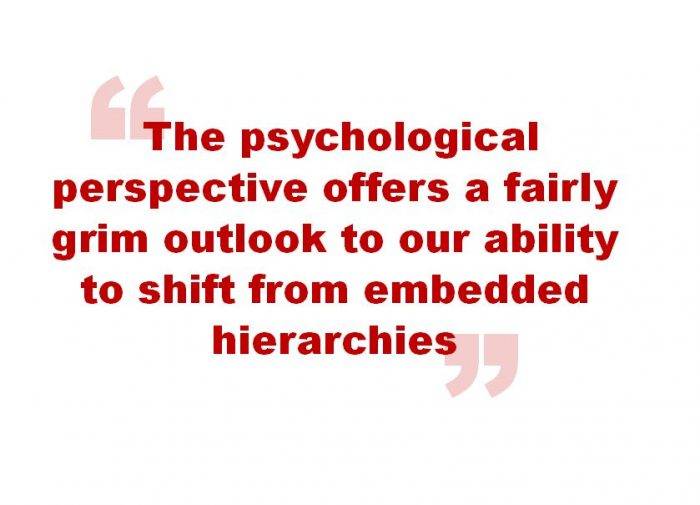 I am a child of the seventies, and one of my favourite shows when I was just a tyke was The Jeffersons. For those not familiar with The Jeffersons, it was about a black family in New York City who had, through ambition and entrepreneurship, ‘made it to the top’. George Jefferson, the patriarch, was a bolshie character. Hijinks usually ensued. But what stuck with me about that show was the catchy theme song, Movin’ On Up. The lyrics were ‘I’m movin’ on up, to the upper east side, to a deluxe apartment in the sky… I finally got a piece of the pie.’ Growing up in suburbia, this was probably the first time that I learned the idea of a penthouse, and the notion that the higher up the building, the more important you were. It wasn’t until I was about age eight that I realised the word wasn’t ‘high-archy’, but ‘hierarchy.’
I am a child of the seventies, and one of my favourite shows when I was just a tyke was The Jeffersons. For those not familiar with The Jeffersons, it was about a black family in New York City who had, through ambition and entrepreneurship, ‘made it to the top’. George Jefferson, the patriarch, was a bolshie character. Hijinks usually ensued. But what stuck with me about that show was the catchy theme song, Movin’ On Up. The lyrics were ‘I’m movin’ on up, to the upper east side, to a deluxe apartment in the sky… I finally got a piece of the pie.’ Growing up in suburbia, this was probably the first time that I learned the idea of a penthouse, and the notion that the higher up the building, the more important you were. It wasn’t until I was about age eight that I realised the word wasn’t ‘high-archy’, but ‘hierarchy.’
Hierarchy is a resilient beast. Hierarchies have survived through economic crashes, world wars, tech revolutions, because they are efficient. Our brains are lazy, and hierarchies provide clarity and structure, but the word hierarchy today is emblematic of not only a structure but the resulting culture as well. Embedded in our lexicon from the ‘corporate ladder’ to the ‘glass ceiling’, hierarchies define our aspirations and our struggles alike.
‘Hierarchy’ first appeared in the Oxford English Dictionary in 1880 as a reference to the three orders of angels as depicted by Pseudo-Dionysius the Areopagite. The term was thereafter adopted, not surprisingly, by the military, and later commercially propagated during the industrial revolution. Formal organisational hierarchies were key to the rapid growth of large conglomerates during that period, and so when the great depression of the 1930’s hit the United States, the organisations with embedded hierarchies were the ones best able to survive. The halo effect from those survivors was that hierarchical systems became synonymous with strength and stability.
 After World War II, there were few businesses that engaged in a single activity; most were large multinational conglomerates. And while the Tayloristic approach of human as machines had begun to fade, the utility of hierarchy models continued to strengthen. By the 1960’s there were two schools of thought about workers as McGregor saw it in The Human Side of Enterprise (1960). They were either lazy layabouts who required constant supervision, or ambitious go-getters who performed best in an atmosphere of trust. And so, it’s somewhat ironic that it was around this time Maslow’s Hierarchy of Needs began to grow in prominence as a rationale for killing off elements of the corporate hierarchical model. A job wasn’t just something to pay the bills, but a means for self-expression and self-actualisation. Maslow’s theory was a great equaliser of sorts; if every person sought the same fulfilment, then perhaps every person should have access to the same opportunities. Enter, the flat organisation.
After World War II, there were few businesses that engaged in a single activity; most were large multinational conglomerates. And while the Tayloristic approach of human as machines had begun to fade, the utility of hierarchy models continued to strengthen. By the 1960’s there were two schools of thought about workers as McGregor saw it in The Human Side of Enterprise (1960). They were either lazy layabouts who required constant supervision, or ambitious go-getters who performed best in an atmosphere of trust. And so, it’s somewhat ironic that it was around this time Maslow’s Hierarchy of Needs began to grow in prominence as a rationale for killing off elements of the corporate hierarchical model. A job wasn’t just something to pay the bills, but a means for self-expression and self-actualisation. Maslow’s theory was a great equaliser of sorts; if every person sought the same fulfilment, then perhaps every person should have access to the same opportunities. Enter, the flat organisation.
Flat is the new black these days. Hierarchy is uncool, man. Supposedly, only 14% of executives believe that the traditional organisational model makes their organisation effective (Bersin, McDowell, Rahnema, & Van Durme, 2017). And people have tried changing systems with (foolish) ideas like Holocracy and the like. But really, when we scratch beneath the surface, not much has fundamentally changed to the cultural underpinning of organisational hierarchy, and there seems to be a lack of genuine interest in trying. It’s simply too ingrained. And too hard.
The cultural impact
If we want to see just how difficult the cultural impacts of hierarchy are to change, we only need to look at the lingering and in some cases, resurgence of white supremacy. The roots of white supremacy stem from a time when mass colonialism collided with the science of enlightenment. When attempting to explain the ease with which white colonials were able to subjugate other races, scientists created the now debunked Theory of Racial Hierarchy (Weitz, 2015). The clarity and structure that racial hierarchy created for society kept everyone in their place. It worked well (for those at the top) for centuries.
That is, until individuals at the bottom wished to be seen as having value based not on their phrenology but their capability and humanity. Even after a systemic change, the lingering after-effects aren’t so easily erased, particularly for those who find their identity wholly integrated into the hierarchy that is being challenged. In search for identity, racists turn to white supremacy. A purely hypothetical question, but what do slighted corporate scions turn to when their hierarchical emblems such as corner offices are taken from them?
Hierarchies soothe us for the very reason that they are so familiar. They give us something to hope for and strive for, they ‘give us structure, security, and [a] tangible vision of ourselves climbing the ladder. [They give us] identity’ (Leavitt, 2003). Linear & bureaucratic, great for stability and resiliency, they are good for growth but bad for creativity and adaptability. And while we see structure and security as hierarchy’s tangible benefits (despite their confines), it is the identity that hierarchies bring us that sits at its crux.

The Assumption of the Virgin by Francisco Botticini 1475, depicting the three hierarchies of angels. National Gallery.
A foreigner takes a job from a local; a partner at a law firm is told that a new office design means they’ve lost their lofty room with a view. Both slights feel as a violation to the psychological contract that has been so deeply rooted explicitly (structurally) and implicitly (culturally) in our existence. By changing the structure, but not changing the culture, you create dissonance, and our brains loathe dissonance. Neither issue is solved simply and the key to both lies in redefining identity.
As we try to break down systems, many people want to join the bandwagon, some well-meaning, and some who wish to appear that way. Some will do the hard work of systemic-change, and others will virtue signal. Executives can listen to podcasts about leader as servant; they can call themselves the Chief Happiness Officer; they can even (horror!) sit in open plan; but it will amount to no more than corporate virtue signalling if they don’t break down the key attributes of cultural hierarchy, chiefly power and choice.
So how do we change hierarchy if we wanted to? The psychological perspective offers a fairly grim outlook to our ability to shift from embedded hierarchies. Behaviourists would say that we are conditioned through centuries of organisational structural evolution. Social Anthropologists would say that humans innately function through categorisation and classification, providing us clarity and certainty. Simultaneously, the centuries past of all manner of working life has been attuned to hegemony under hierarchical structures (Burton, 2017). This is borne out by the secretaries who complain on behalf of their bosses when they lose the corner office. Like a learned helplessness, we submit and actually expect dominance from our bosses and organisations.
If the key lies in a shared identity, then that identity must be mutually constructed, mutually modelled and mutually powered (Hatch, 2011). Decisions should be ‘nested,’ with each level having autonomy for their piece and the ability to contest the decision that came before (Martin, 2014). But be careful what you wish for, because a mutually modelled organisation means people become emotionally invested in the organisational culture, requiring constant maintenance, support and ‘communication through contestation’, (i.e. clear channel communication that allows for debate and discourse about the merits and values of a shared corporate identify) (Deloitte, 2017).
Hierarchy doesn’t need exploding, it needs editing. Keep the clarity of a networked organisation, but erase the bureaucracy. Keep the managers but make them enablers, not gate-keepers. Keep approval processes, but as peer-reviewed, not management fiat (Martin, 2014). Keep job titles, but reduce the massive inequities.
In the immortal words of Ice-T, ‘don’t hate the player, hate the game.’ Hierarchy can be beautiful. Music, the most elegant of structures, is hierarchical in nature. Without hierarchy, there would be insufficient order to create the resonance of harmonics in our brains (Levitan, 2007). Hierarchy as a tool, absent the turgid, arrogant or predatory culture that frequently accompanies it can be an elegant mechanism for achieving harmony and structure. More likely, it will continue to be used as the blunt instrument of order and oppression it has become.
This piece also appears in Work&Place
____________________________________
 Monica Parker is a world renowned expert on organisational change and the founder of HATCH Analytics. She is a regular blogger for the Huffington Post and has appeared on BBC Worldwide as an authority on workplace strategy. Monica studied design at the University of Miami and received her MSc (Distinction) in Sustainable Management from Queens University Belfast with a specialism in using data analytics and social science in predictive behaviour. You can follow her on Twitter or email her at monica@hatchanalytics.com.
Monica Parker is a world renowned expert on organisational change and the founder of HATCH Analytics. She is a regular blogger for the Huffington Post and has appeared on BBC Worldwide as an authority on workplace strategy. Monica studied design at the University of Miami and received her MSc (Distinction) in Sustainable Management from Queens University Belfast with a specialism in using data analytics and social science in predictive behaviour. You can follow her on Twitter or email her at monica@hatchanalytics.com.














September 28, 2018
The horrors and harmonies of workplace hierarchy
by Monica Parker • Comment, Technology, Workplace design
Hierarchy is a resilient beast. Hierarchies have survived through economic crashes, world wars, tech revolutions, because they are efficient. Our brains are lazy, and hierarchies provide clarity and structure, but the word hierarchy today is emblematic of not only a structure but the resulting culture as well. Embedded in our lexicon from the ‘corporate ladder’ to the ‘glass ceiling’, hierarchies define our aspirations and our struggles alike.
‘Hierarchy’ first appeared in the Oxford English Dictionary in 1880 as a reference to the three orders of angels as depicted by Pseudo-Dionysius the Areopagite. The term was thereafter adopted, not surprisingly, by the military, and later commercially propagated during the industrial revolution. Formal organisational hierarchies were key to the rapid growth of large conglomerates during that period, and so when the great depression of the 1930’s hit the United States, the organisations with embedded hierarchies were the ones best able to survive. The halo effect from those survivors was that hierarchical systems became synonymous with strength and stability.
Flat is the new black these days. Hierarchy is uncool, man. Supposedly, only 14% of executives believe that the traditional organisational model makes their organisation effective (Bersin, McDowell, Rahnema, & Van Durme, 2017). And people have tried changing systems with (foolish) ideas like Holocracy and the like. But really, when we scratch beneath the surface, not much has fundamentally changed to the cultural underpinning of organisational hierarchy, and there seems to be a lack of genuine interest in trying. It’s simply too ingrained. And too hard.
The cultural impact
If we want to see just how difficult the cultural impacts of hierarchy are to change, we only need to look at the lingering and in some cases, resurgence of white supremacy. The roots of white supremacy stem from a time when mass colonialism collided with the science of enlightenment. When attempting to explain the ease with which white colonials were able to subjugate other races, scientists created the now debunked Theory of Racial Hierarchy (Weitz, 2015). The clarity and structure that racial hierarchy created for society kept everyone in their place. It worked well (for those at the top) for centuries.
That is, until individuals at the bottom wished to be seen as having value based not on their phrenology but their capability and humanity. Even after a systemic change, the lingering after-effects aren’t so easily erased, particularly for those who find their identity wholly integrated into the hierarchy that is being challenged. In search for identity, racists turn to white supremacy. A purely hypothetical question, but what do slighted corporate scions turn to when their hierarchical emblems such as corner offices are taken from them?
Hierarchies soothe us for the very reason that they are so familiar. They give us something to hope for and strive for, they ‘give us structure, security, and [a] tangible vision of ourselves climbing the ladder. [They give us] identity’ (Leavitt, 2003). Linear & bureaucratic, great for stability and resiliency, they are good for growth but bad for creativity and adaptability. And while we see structure and security as hierarchy’s tangible benefits (despite their confines), it is the identity that hierarchies bring us that sits at its crux.
The Assumption of the Virgin by Francisco Botticini 1475, depicting the three hierarchies of angels. National Gallery.
A foreigner takes a job from a local; a partner at a law firm is told that a new office design means they’ve lost their lofty room with a view. Both slights feel as a violation to the psychological contract that has been so deeply rooted explicitly (structurally) and implicitly (culturally) in our existence. By changing the structure, but not changing the culture, you create dissonance, and our brains loathe dissonance. Neither issue is solved simply and the key to both lies in redefining identity.
As we try to break down systems, many people want to join the bandwagon, some well-meaning, and some who wish to appear that way. Some will do the hard work of systemic-change, and others will virtue signal. Executives can listen to podcasts about leader as servant; they can call themselves the Chief Happiness Officer; they can even (horror!) sit in open plan; but it will amount to no more than corporate virtue signalling if they don’t break down the key attributes of cultural hierarchy, chiefly power and choice.
So how do we change hierarchy if we wanted to? The psychological perspective offers a fairly grim outlook to our ability to shift from embedded hierarchies. Behaviourists would say that we are conditioned through centuries of organisational structural evolution. Social Anthropologists would say that humans innately function through categorisation and classification, providing us clarity and certainty. Simultaneously, the centuries past of all manner of working life has been attuned to hegemony under hierarchical structures (Burton, 2017). This is borne out by the secretaries who complain on behalf of their bosses when they lose the corner office. Like a learned helplessness, we submit and actually expect dominance from our bosses and organisations.
If the key lies in a shared identity, then that identity must be mutually constructed, mutually modelled and mutually powered (Hatch, 2011). Decisions should be ‘nested,’ with each level having autonomy for their piece and the ability to contest the decision that came before (Martin, 2014). But be careful what you wish for, because a mutually modelled organisation means people become emotionally invested in the organisational culture, requiring constant maintenance, support and ‘communication through contestation’, (i.e. clear channel communication that allows for debate and discourse about the merits and values of a shared corporate identify) (Deloitte, 2017).
Hierarchy doesn’t need exploding, it needs editing. Keep the clarity of a networked organisation, but erase the bureaucracy. Keep the managers but make them enablers, not gate-keepers. Keep approval processes, but as peer-reviewed, not management fiat (Martin, 2014). Keep job titles, but reduce the massive inequities.
In the immortal words of Ice-T, ‘don’t hate the player, hate the game.’ Hierarchy can be beautiful. Music, the most elegant of structures, is hierarchical in nature. Without hierarchy, there would be insufficient order to create the resonance of harmonics in our brains (Levitan, 2007). Hierarchy as a tool, absent the turgid, arrogant or predatory culture that frequently accompanies it can be an elegant mechanism for achieving harmony and structure. More likely, it will continue to be used as the blunt instrument of order and oppression it has become.
This piece also appears in Work&Place
____________________________________